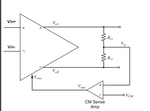Junus2012
Advanced Member level 5
Dear friends,
could you please tell me how to simulate the input offset voltage of the fully differential amplifier,
the second question is how we can compensate for the offset voltage by while we have common mode feedback loop which always control the currents.
Thank you very much
could you please tell me how to simulate the input offset voltage of the fully differential amplifier,
the second question is how we can compensate for the offset voltage by while we have common mode feedback loop which always control the currents.
Thank you very much

